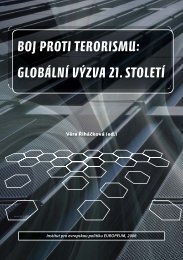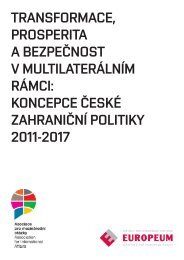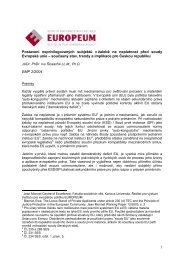eu constitutionalisation - EUROPEUM Institute for European Policy
eu constitutionalisation - EUROPEUM Institute for European Policy
eu constitutionalisation - EUROPEUM Institute for European Policy
You also want an ePaper? Increase the reach of your titles
YUMPU automatically turns print PDFs into web optimized ePapers that Google loves.
Chapter 6: A ‘saut constitutionnel’ out of an intergovernmental trap?These <strong>for</strong>mulations of the legal constitution leave a large grey area <strong>for</strong> theliving constitution of the future: will the UMFA in line with the overarchingguidelines of the <strong>European</strong> Council and in view of his/her role <strong>for</strong> implementinga “<strong>European</strong> Security Strategy” (<strong>European</strong> Council 2003) ask<strong>for</strong> a dominating single purpose role within the Commission, i.e. pursuea ‘catch-all’ strategy, or will this person stay within a broader, more differsomekind of strong executive agency. The new feature is that the personis endowed with a ‘double-hat’⁴² being embedded in the Commission aswell as in the Council.The double embedment is clearly apparent in the respective procedures<strong>for</strong> the election as well as <strong>for</strong> the removal from office: “The <strong>European</strong>Council, acting by qualified majority, with the agreement of the Presidentof the Commission, shall appoint the Union Minister <strong>for</strong> Foreign Affairs”(Art. I-28 (1)). The same procedure applies <strong>for</strong> the termination of hismandate. In view of the proposed requirements <strong>for</strong> a qualified majorityvote in the Council (Art. I-25 (1)) the Minister, after the nomination, willhave to secure the support of larger member states, of which three andanother fourth state would possess a blocking minority (Art. I-25 (1)) – ifthe Federal Republic of Germany were included. But also the pre-electedPresident of the Commission will be a key player in this process. The provisions<strong>for</strong> electing the Commission are equally relevant <strong>for</strong> assessing theaccountability of this person. The President, as well as the College including“the Union Minister <strong>for</strong> Foreign Affairs […] shall be subject as a body toa vote of approval by the <strong>European</strong> Parliament” (Art. I-27 (2)). The UnionMinister thus also needs to get backing from the <strong>European</strong> Parliament. Ifthe two relatively largest groups continue to <strong>for</strong>m some kind of ‘grandcoalition’ within the EP both will try to distribute the posts of the Presidentand this Vice President of the Commission among themselves along partylines. This role of the EP extends also to a motion of censure, after which“the members of the Commission shall resign as a body and the UnionMinister <strong>for</strong> Foreign affairs shall resign from duties that he or she carriesout in the Commission” (Art. III-340).The UMFA also needs to be aware of the newly extended rights of theCommission President: “A Member of the Commission shall resign if thePresident so requests” (Art. I-27 (3)), though the resignation of the UMFAtakes place “in accordance with the procedure set out in Article I-28 (1)”,which means that the President of the Commission would need to get supportfrom the <strong>European</strong> Council. The text does not explain the details of42) For the term „double hat“ see the contribution by the alternate delegate of the German government tothe Convention, Gunter Pl<strong>eu</strong>ger, “Double Hat”, Working Group VII on External Action, Working document17, 5.11.2002, http://<strong>eu</strong>ropean-convention.<strong>eu</strong>.int/docs/wd7/4484.pdf, and the Final report of WorkingGroup VII, CONV 459/02, 16.12.2002, http://register.consilium.<strong>eu</strong>.int/pdf/en/02/cv00/00459en2.pdf[23.11.2005].214Chapter 6: A ‘saut constitutionnel’ out of an intergovernmental trap?this procedure. Overall, the Foreign Minister is accountable to two bodies<strong>for</strong> his election and during the execution of his office. Via its powers ofcontrol and dismissal vis-à-vis the Commission the EP can also extend itspower towards the Union Minister.The tasks of the Foreign Minister constitute a considerable workload anda broad responsibility. Several functions can be identified: the UnionMinister should serve as the external representative of the Union, as initiatorand executor of <strong>European</strong> decisions, as chair of the Council of ForeignAffairs and as ‘guardian’ of the regime of self-coordination (see above) aswell as Vice President of the Commission (see <strong>for</strong> details graph 1).Also in matters of the CSDP, the Foreign Minister, “acting under the authorityof the Council and in close and constant contact with the Political andSecurity Committee (PSC), shall ensure coordination of the civilian andmilitary aspects of such tasks” (Art. III-309 (2)). The PSC retains, however,“under the responsibility of the Council and of the Union Minister <strong>for</strong>Foreign Affairs”, the main tasks of “political control and strategic directionof … crisis management operations”. The Committee can also beauthorised by the Council of Ministers “to take the relevant measures” (Art.III-307 (2)). Finally, the Foreign Minster is involved in the decision-makingprocedures <strong>for</strong> the “permanent structured cooperation” (Art. III-312(2) and (3)).In addition to this profile as ‘enhanced successor’ to the present ‘HighRepresentative’ (Art. 26 TEU), the constitutional treaty gives the ForeignMinister an extended role within the Commission: “The Union Minister<strong>for</strong> Foreign Affairs shall be one of the Vice-Presidents of the Commission.He or she shall ensure the consistency of the Union’s external action” and“he or she shall be responsible within the Commission <strong>for</strong> responsibilitiesincumbent on it in external relations and <strong>for</strong> coordinating other aspects ofthe Union’s external action” (Art. I-28 (4)).215








